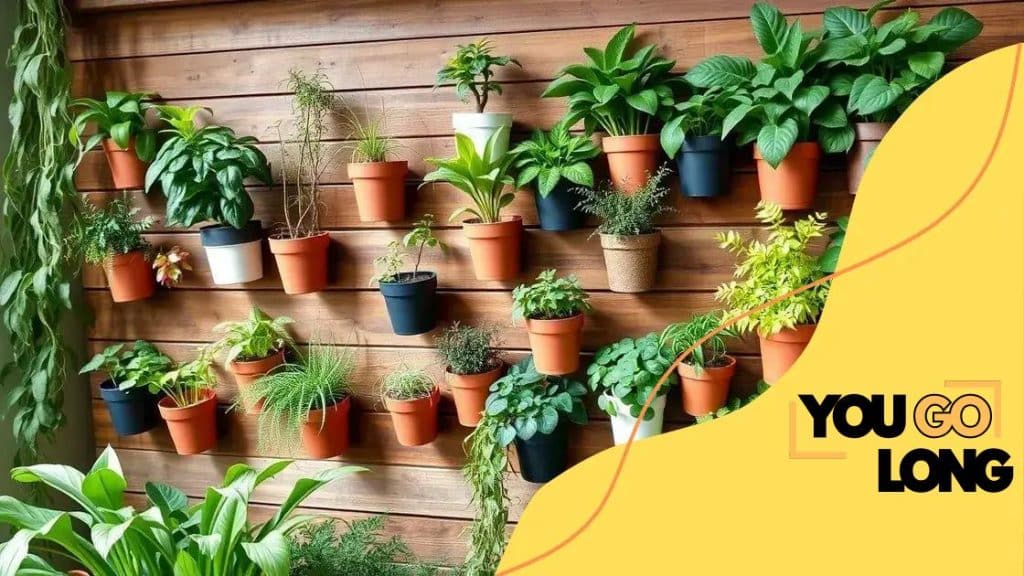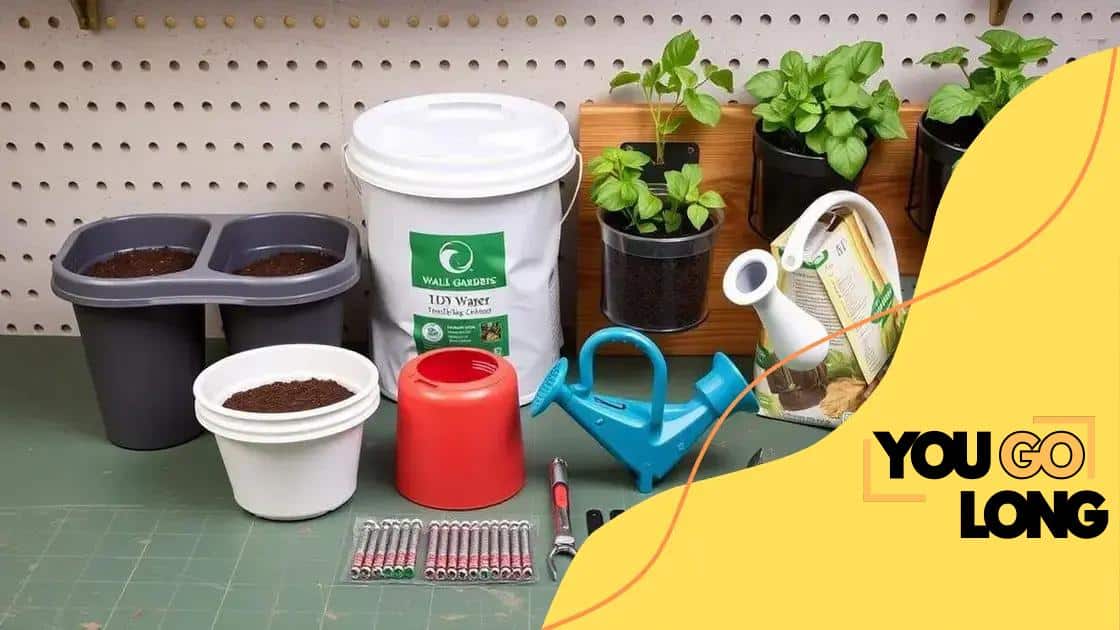How to create a DIY wall garden for indoor plants

Advertisement
To create a DIY wall garden for indoor plants, choose a suitable location, select low-maintenance plants, gather necessary materials, mount the containers, and maintain them with regular watering and pruning.
Are you curious about how to create a DIY wall garden for indoor plants? It’s a fantastic way to bring a touch of greenery into your home. Let’s explore how you can achieve this stylish decor while enjoying the benefits of nature indoors.
Choosing the right location for your wall garden
Choosing the right location for your wall garden is crucial for the health and growth of your indoor plants. A well-placed wall garden not only enhances your home’s aesthetics but also ensures that your plants thrive.
Factors to Consider
When selecting the location, consider several important factors that contribute to the success of your garden.
Advertisement
- Light Exposure: Ensure your plants receive adequate sunlight. South-facing walls usually get the most light.
- Humidity Levels: Choose areas with optimal humidity for the plants you select; some thrive in drier air while others prefer more moisture.
- Accessibility: Position your wall garden where you can easily reach it for watering and maintenance.
- Aesthetic Appeal: Consider how the garden will look in your home. A well-placed garden can act as a stunning focal point.
Now that you know the key factors, think about how light can change throughout the day. You might need to adjust your wall garden depending on seasonal changes, too. Observing your space over a few days will help you determine the best spot.
Testing Different Locations
Don’t hesitate to test different locations before making a final decision. Use temporary placements or hang plants in various positions to see how they fare. Watching how the light hits your wall at different times can provide insight into the best place for your DIY wall garden.
Creating the right environment for your plants is essential. Remember that each plant species may have unique needs, so make sure to research them. The perfect location will help your indoor garden flourish and become an integral part of your home’s decor.
Advertisement
Selecting the best indoor plants for your space
Selecting the best indoor plants for your space is essential for a successful DIY wall garden. Different plants have unique needs, and finding the right ones can make all the difference.
Types of Indoor Plants
To start, consider the types of plants that will thrive in your home environment. Not all plants are suitable for every indoor space. Here are some popular options:
- Succulents: They require minimal water and can adapt to various light conditions.
- Snake Plant: Known for being low-maintenance, it’s perfect for beginners.
- Pothos: A vine that grows well in low light and can be trained to grow in various directions.
- Spider Plant: It’s easy to care for and produces baby plants, allowing for expansion of your wall garden.
Think about the lighting in your chosen location. Some plants require bright, indirect light, while others can thrive in lower light conditions. Observe the sunlight patterns in your space before making a choice.
Research Specific Needs
Once you have a few plants in mind, research their specific care requirements. Consider factors like water needs, humidity levels, and if they prefer to be in direct sunlight or shade. This research will help ensure that your indoor wall garden remains healthy and vibrant.
For example, plants like ferns enjoy a humid environment, making them ideal for a bathroom wall garden, while cacti are best suited for bright, sunny spots. Matching the right plant to the right environment is key.
Finally, don’t forget to think about the visual impact of your plants. Mixing different sizes, textures, and colors not only enhances the overall design of your wall garden but also creates a more engaging display. Arrange plants at varying heights and consider both trailing and upright options for visual diversity.
Materials needed for your DIY project

Gathering the right materials is crucial for your DIY wall garden project. This step ensures that you have everything you need for a successful setup without unnecessary delays.
Essential Materials
Below is a list of the essential materials you will need to create your indoor wall garden.
- Planting Containers: Use pots, vertical planters, or wall-mounted holders. Choose sizes that suit the plants you selected.
- Soil: Opt for a high-quality potting mix that provides good drainage and nutrients.
- Watering Can or Spray Bottle: Having a good watering tool is vital for keeping your plants healthy.
- Wall Mounting Hardware: Depending on your setup, you may need hooks, screws, or brackets to secure your containers.
- Garden Tools: Basic tools like trowels, scissors, and gloves make planting and maintenance easier.
These materials form the backbone of your wall garden. It’s important to choose durable containers that can handle the weight of the soil and plants, especially if you are mounting them on a wall.
Extras to Consider
While the essentials are listed, you might also want to consider some additional items. These extras can enhance both the look and functionality of your garden. Think about decorative rocks or moss for a stylish touch, or self-watering systems for convenience.
If you are a beginner, don’t let the material list overwhelm you. You can start simple and expand your garden as you gain confidence. Over time, you may discover what works best for your plants and space.
Step-by-step guide to building your wall garden
Building your wall garden can be a fun and rewarding process. Follow this step-by-step guide to create a beautiful DIY wall garden that will enhance your indoor space.
Step 1: Choose Your Location
Begin by identifying the best wall in your home. Look for a spot that receives adequate sunlight. Keep in mind that some plants thrive in brighter light, while others do well in partial shade.
Step 2: Gather Your Materials
Before you start, make sure you have all the necessary materials ready. The list includes planting containers, quality soil, and wall mounting hardware. Having everything on hand will make the process smoother.
Step 3: Prepare the Wall and Containers
If necessary, prep the wall by cleaning it and ensuring it’s suitable for mounting. For containers, if you’re using pots, make sure they have drainage holes. This helps prevent water accumulation and root rot.
Step 4: Arrange Your Plants
Before attaching containers to the wall, arrange the plants in the pots to see how they look together. This trial run helps you visualize the final design and allows adjustments before the permanent setup.
Step 5: Mount the Containers
Start attaching your prepared containers to the wall, following your planned arrangement. Use the wall mounting hardware securely. Make sure each container is mounted at a height that is easy to access.
Step 6: Add Soil and Plants
Once the containers are secure, fill them with the soil you prepared. Gently plant each plant into its container, ensuring they are well-placed and firmly secured within the soil.
Step 7: Water Your Garden
After planting, water your wall garden to settle the soil around the roots. This is an important step, as it helps your plants adapt to their new environment.
Step 8: Maintain Your Wall Garden
Regular maintenance is key to keeping your garden healthy. Water your plants as needed, check for pests, and ensure they receive the appropriate light. Trimming dead leaves also promotes new growth.
By following these steps, you can create a stunning and vibrant wall garden that enhances your indoor space.
Tips for maintaining your indoor garden
Maintaining your indoor garden is essential for keeping your plants healthy and vibrant. Regular care not only encourages growth but also enhances the beauty of your DIY wall garden.
Watering Schedule
Establishing a consistent watering schedule is key. Water your plants based on their specific needs; some may require more frequent watering than others. Be careful not to overwater, as this can lead to root rot.
Light Requirements
Check the light conditions in your home. Ensure that your plants are getting enough sunlight, adjusting their positions if necessary. You may need to rotate your plants occasionally to ensure even growth.
Regular Pruning
Pruning dead or yellowing leaves encourages new growth. Keep an eye on your plants and remove any unwanted foliage. This practice not only maintains health but also keeps the garden looking tidy.
- Trim Dead Leaves: Regularly check for any dead or dying leaves.
- Clean Debris: Remove dust and debris from the plant leaves to allow for proper light absorption.
- Monitor for Pests: Keep an eye out for pests that may affect your plants and treat them promptly.
- Fertilization: Use appropriate fertilizers to provide essential nutrients, especially in growing seasons.
Providing adequate humidity is another aspect of care. Most indoor plants thrive in humidity levels between 40-60%. You might consider misting your plants or placing a humidifier nearby to create a suitable environment.
Remember that each plant may have different requirements. Tailoring your care routine to the specific needs of your plants will yield the best results. By staying attentive and adjusting your practices, your indoor garden will flourish.
Creating a DIY wall garden is a rewarding and creative endeavor that can transform your indoor space. By choosing the right location, selecting suitable plants, and maintaining them with care, you can cultivate a thriving garden that beautifies your home. Remember to be patient as your plants grow and flourish, and don’t hesitate to experiment with different arrangements and plant species. With a little effort and attention, your wall garden will soon become a vibrant part of your indoor environment.
FAQ – Frequently Asked Questions about DIY Wall Gardens
What types of indoor plants are best for a wall garden?
Some great options include succulents, snake plants, pothos, and spider plants, as they thrive well indoors.
How do I determine the right location for my wall garden?
Choose a location with adequate natural light and easy access for maintenance and watering.
How often should I water my indoor plants?
Watering frequency depends on the plant type, but generally, check the soil moisture and water when it’s dry to the touch.
What should I do if my plants show signs of pests?
Inspect your plants regularly and treat any infestations immediately with insecticidal soap or neem oil to protect their health.





